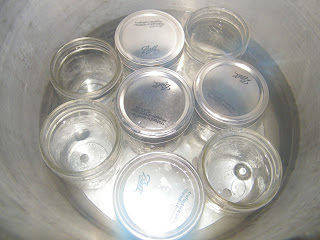For years my husband and his family have made Dilly Beans. They were the pint size mason jars at parties and gatherings, where sometimes a warning would be given about just how 'hot' they were. I am known for my aversion to hot/spicy food, so I stayed far away. However, in June my husband and I went to visit my eldest brother to celebrate his sons graduation. It was going to be a packed house and we wanted to bring down some snacks. My last visit I had been talking about pickling foods, and my sister-in-law didn't think that she'd had pickled sausages or pickled eggs before (I'm still experimenting with recipes for those!) so hubby and I picked up some pickled sausages from a local store that we love (Locust Grove in Argyle, NY) and he brought some dilly beans he had made last year. After a little persuasion, and being told they were just a little bit more spicy than the sausages, I finally tried them, and liked them. They had a bit of a kick, but at least this batch, was more flavorful than overwhelmingly hot. So this year, I was more than happy to help make them.
I'm going to give 2 recipes, they are pretty much the same, except for the peppers. The first is the tried and true family recipe, and the second is what we threw together when someone bought the wrong peppers (I won't name names, but the store only had two types and HE thought he'd just get what they had)... and I have a feeling they may be too hot for my liking, but time will tell, and those that like the spicy may enjoy the change in peppers..
DILLY BEANS RECIPE #1
Yields 4-5 Pint JarsBase Liquid/Brine :
3 Cups Vinegar
3 Cups Water
1/2 cup Canning Salt
Green Beans
Fresh Dill (A stalk or so in each jar)
4 Garlic Cloves (about 1 clove, chopped per jar)
OR
Cayenne pepper powder (a pinch in each jar)
 |
| The pepper on the left is a Jalapeno, which we used in Recipe #2. |
Step 1: Sanitize Jars
Step 2: Make the brine
Step 3: Cut the ends off of the green beans and trim so that they fit the jar leaving about a 1/2 inch of space from the top.
Step 4: Add Green Beans, chopped Garlic, Dill and Cayenne pepper to the jars.
Step 5: Pour the brine mix into the filled jars, leaving a small gap of space at the top.
Step 6: Boil in a canner for 10 minutes.
Step 7: Remove and let sit until cool. Make sure that the cans are sealed.
JALAPENO DILLY BEANS RECIPE #2
Yields 4-5 Pint Jars
Base Liquid/Brine:
3 Cups Vinegar
3 Cups Water
1/2 cup Canning Salt
Green Beans
Fresh Dill (A stalk or so in each jar)
4 Garlic Cloves (about 1 clove, chopped per jar)
Jalapeno peppers (1/2 a small pepper or a 1/4 of a large pepper per jar)
Step 1: Sanitize Jars
Step 2: Make the brine


Step 3: Cut the ends off of the green beans and trim so that they fit the jar leaving about a 1/2 inch of space from the top.
 |
| Apparently putting the jar on it's side and filling it that way helps to pack them in better, according to my father-in-law. Seemed to work, but had to secure the jars so they didn't roll off the table. |
 | ||||
| I tried for uniform cutting, so I measured one and left it as a guide while cutting the rest. It also helps to pick the straightest beans you can. |
Step 4: Add Green Beans, chopped Garlic, Dill and Jalapeno peppers to the jars.
 |
| Hard to tell scale, but we used just one piece of above per jar. |
Step 5: Pour the brine mix into the filled jars, leaving a small gap of space at the top.
Step 6: Boil in a canner for 10 minutes.
 |
| This batch we just did 4 pints, and until the smaller canner shelf I ordered comes in, we added empty bottles to stabilize the others. |
Step 7: Remove and let sit until cool. Make sure that the cans are sealed.
Step 8: Let sit for at least a few weeks before enjoying.
Well, that's it for our Dilly Bean recipes. I'll try to remember to update on how the Jalapeno's taste vs. the traditional Cayenne.









































